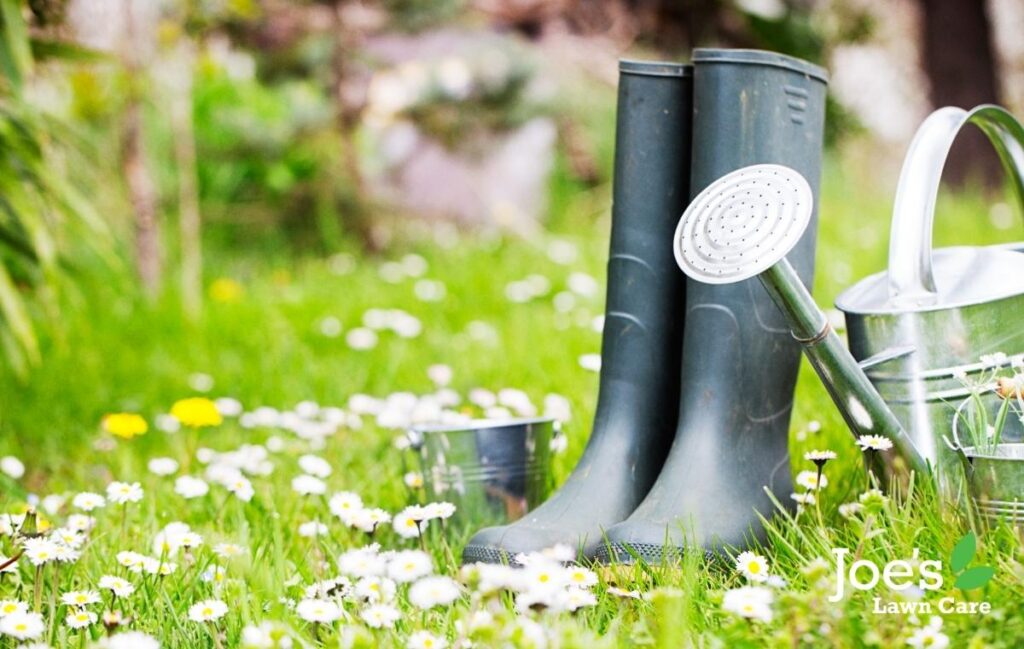These Spring Tasks Guarantee A Great Lawn
After a long and dreary winter spent in hibernation, nothing beats those first signs of spring. The longer days, stopping to smell the flowers, watching a whole world of colour open up in a way that overwhelms your senses (and sinuses). And reminding us that now is the time to get your lawn prepped n’ primed for growing season.
That’s right. It’s time to dust off your gardening gloves, reacquaint yourself with the law and order of your cobwebbed shed. Yank the starter cord on your trusty mower and then tick off every item on this springtime task list. This is so you’re patch of turf is ready to become the happiest and healthiest it has ever been. Let’s do this:

Task #1: Rakes Before Mates
The moment you see a daffodil show some interest in blooming, the first thing you need to do is grab your flexible leaf rake. Why? To prepare your lawn for all that new growth coming in hot. Yepp. You can forget all about those fallen leaves you only just noticed. That’s because this raking session is about one thing and one thing only: removing any lawn thatch.
Of course, there are other reasons to start raking at this time of year. Such as getting rid of matted patches that have probably been caused by snow mould. That’s one of the nasty lawn diseases that will make it hard for new grass to penetrate this matted mess.
Task #2: Aeration is Essential
After being stuck indoors for almost two years, there’s a pretty big chance your lawn has suffered from some pretty heavy traffic. Lapping up those rare sunny days, playing with the kids, hosting BBQs over the neighbours fence and letting your dogs out to burn off some energy. It can all cause soil compaction. Don’t believe us, just look for any signs of moss, which thrives on compacted soil. That’s where lawn aeration comes in.
Long story short, lawn aerators (especially fracture-tine aerators) are used to create loads of deep slices which cracks the soil throughout your lawn. This makes it way easier for water, air and nutrients to get further down into your soil and reach the network of deep roots. That’s super important because a healthy lawn comes from healthy roots.
Task #3: Study your Soil
If there’s one thing grass really-really likes, it’s soil with a neutral pH level. Anything else and you’re going to make it harder for your grass to grow strong, thick and healthy as it battles against tough growing conditions and moss. Luckily, there are some easy ways to amend your soil’s pH level. All of which start with testing your soil. Once you’ve done that and assessed which side of neutral your soil sits, you’ll be able to make the necessary adjustments. And able to give your grass the ideal growing conditions to thrive on.
Task #4: Time To Overseed
Once spring starts pushing winter to one side for another year, you’ll finally get a clear picture of what your lawn looks like after battling the cooler conditions. We’re talking about bare patches dotted around your lawn. The kind that are commonly caused by dog wee, heavy traffic or just winter neglect. The answer: overseeding those bare patches with grass seeds.
To do this most effectively, try adding some slow-release nitrogen fertiliser to your new grass seed and then fill in the bald patches as you find them. Once you’ve done this, try and keep these new seeds nice and moist until you notice them sprouting. Once this happens, continue to keep an eye on your new grass shoots for the next 4 to 6 weeks and then resume your normal fertiliser routine.
Task #5: A Friendly Fertiliser
There are risks to using too much fertiliser in the spring – the kind that can cause disease and weed problems. – This is why we recommend you keep things nice and environmentally friendly for now by using a compost topdressing as your fertiliser, or even using a mulching mower to finely chop-up your lawn clippings so that they become a nourishing source of nitrogen.
That said, if you do want fertiliser with fast-acting benefits, just make sure you stick to a lighter feed, especially if you fertilised at the end of fall.
Task #6: Love A Weed-Free Lawn
There are certain seriously rare things that almost everyone has in common, and a weed-free lawn is one of those things. That’s what makes spring such an important season. Translation: spring lawn care is as all about weed prevention (well, that and creating the ideal conditions to grow a healthy lawn). The issue is, not all weeds can be dealt with in the same way.
Depending on the kind of weeds popping up amongst your turf, you’ll either need to arm yourself with a pre-emergent herbicide or a post-emergent herbicide. And in some instances you might need a mix of both (yeah, we’re looking at you crabgrass). Just make sure you speak to one of our lawn care specialists before you use a pre-emergent herbicide as they can actually work against any new grass seeds you put down. Not to mention they shouldn’t be paired with or overlap any core aeration plans you have.
Task #7: Make Your Mower Great Again
The birds are singing, the flowers are blooming, the sun is shining and your mower is about to become your BFF. That’s precisely why now is the ideal time for a service. Of course, there is only one place to focus your tune-up when it comes to lawn care and that’s your mower blade.
To put it bluntly (ba dum dum dush), a regularly sharpened blade will cleanly slice through your grass, while a dull blade will tear, leaving your grass open to long-term problems, including disease – and no one wants that.
Thanks for reading our guide to These Spring Tasks Guarantee A Great Lawn. For more lawn care tips and tricks, follow us on Facebook and Instagram.





